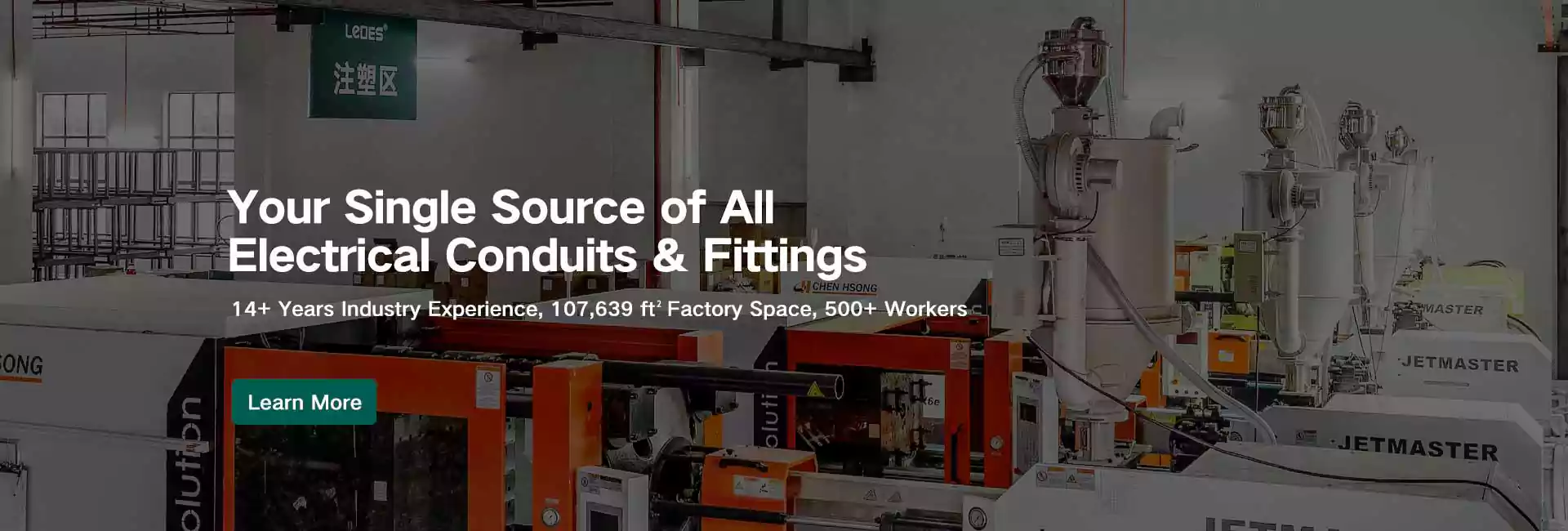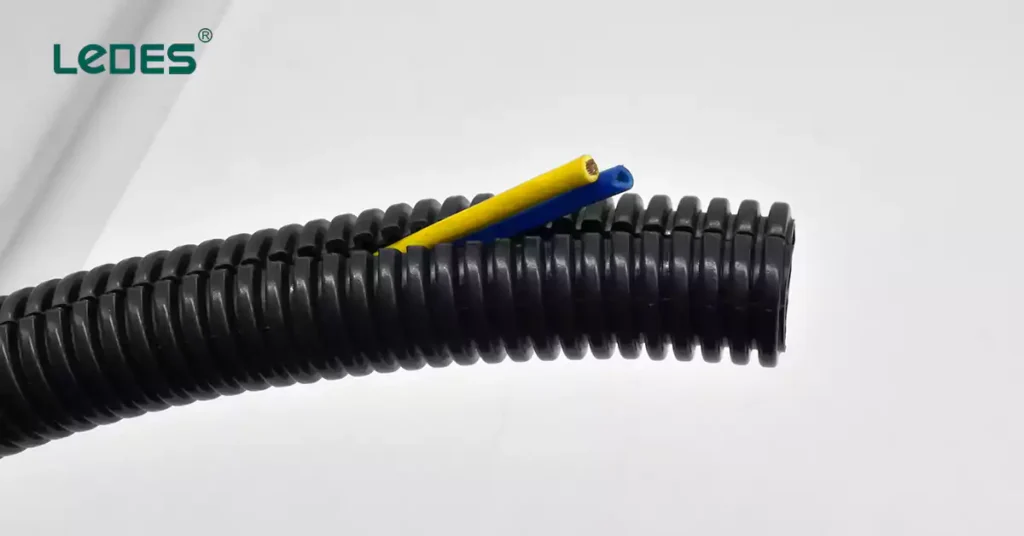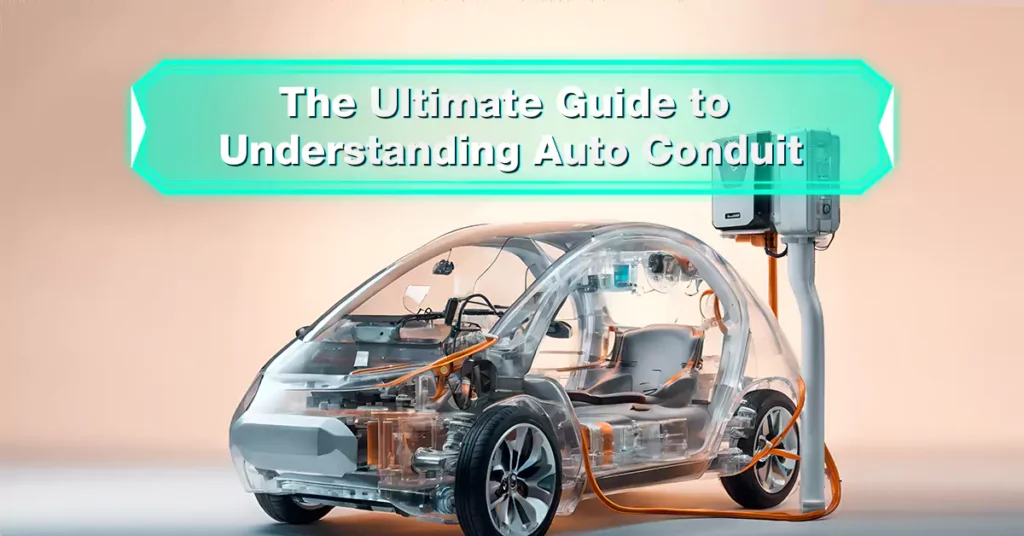
목차
전기 자동차 산업의 급속한 발전과 함께 자동차 전선관이 점차 저희의 비전으로 자리 잡았습니다. 전통적인 케이블 전선관 공급업체로서, 저희는 플라스틱 전선관이 겉보기에는 눈에 잘 띄지 않지만 매우 중요하다는 것을 잘 알고 있습니다.
이 글에서는 자동차 전기 배선에 대한 관련 내용을 자세히 살펴보겠습니다. 이 글을 읽으면 다음과 같은 내용을 배울 수 있습니다.
자동 전선관이란 무엇이고, 어떻게 작동하나요?
전기 시스템에 자동 전선관이 중요한 이유는 무엇입니까?
자동차 배관에 적합한 크기를 어떻게 선택합니까?
그리고 더 많은 것들이 있습니다. 자, 시작해 볼까요?
자동차 전선관은 차량의 전기 배선을 보호하고 연결하는 데 사용되는 파이프입니다. 자동차 전선관은 금속이나 플라스틱으로 제작될 수 있습니다. 대부분의 전선관은 분리형 연성 전선관이지만, 경성 전선관도 특정 용도로 사용됩니다.
자동차 전선관과 PVC 전기 전선관은 자동차 산업의 엄격한 성능 요건을 충족하도록 설계되었습니다. 특히 엔진룸의 까다로운 조건에서 내부 전선을 충격, 박테리아, 화학 물질 및 기타 부식으로부터 보호합니다.
우리 모두 알다시피, 전기 자동차는 전압이 높은 경우가 많기 때문에 내부 전선이 끊어져 단락이나 순간적인 고전압이 발생하면 자동차나 운전자, 승객에게 잠재적인 위험을 초래할 수 있습니다.
자동차 전기 도관은 단순히 전선을 연결하는 튜브가 아닙니다. 전기를 안전하고 효율적으로 전달하는 동시에 다양한 잠재적 위험으로부터 보호하는 보호 경로 역할을 합니다. 전기 자동차 순환계의 동맥과 같은 역할을 하며, 필수 에너지가 목적지에 안전하게 도달하도록 합니다.
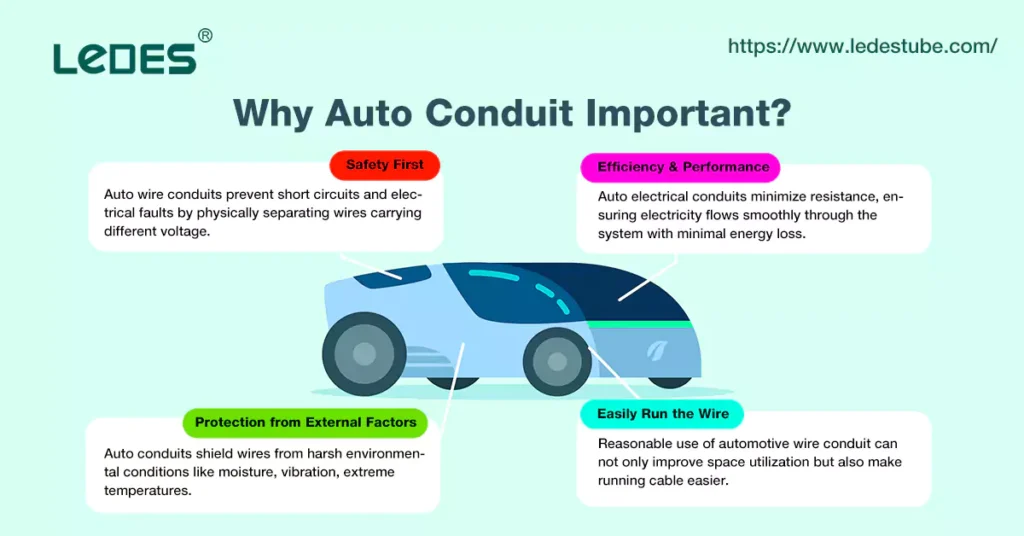
안전이 최우선입니다. 자동차 배선 도관은 서로 다른 전압을 전달하는 전선을 물리적으로 분리하여 단락 및 전기적 결함을 방지하고 과열, 화재 및 부상 위험을 줄입니다. 미국 도로교통안전국(NHTSA)의 2022년 보고서에 따르면, 배선 결함이 전기 시스템 관련 차량 리콜 건수 약 10%의 주요 원인으로 지적되었습니다.
효율성 및 성능: 자동차 전기 기음온듀트는 저항을 최소화하여 전기가 시스템을 통해 원활하게 흐르도록 하고, 에너지 손실을 최소화합니다. 이는 모든 와트가 중요한 전기차의 성능과 주행 거리 향상으로 이어집니다.
외부 요인으로부터의 보호: 자동차 전선관은 습기, 진동, 극한의 온도, 심지어 부식성 도로 잔해와 같은 혹독한 환경 조건으로부터 전선을 보호합니다. 이러한 내구성은 수명 연장과 장기간 안정적인 전기 성능 유지에 필수적입니다.
전선을 쉽게 연결하세요. 신에너지 자동차의 내부 공간, 특히 엔진룸이나 차체는 매우 콤팩트합니다. 자동차용 전선관을 적절히 사용하면 공간 활용도를 높일 뿐만 아니라 케이블 배선도 더욱 수월해집니다. 수리나 유지보수가 필요한 경우에도 케이블을 쉽게 추가하거나 제거할 수 있어 전선의 외관을 더욱 아름답게 만들고 잠재적 위험을 방지할 수 있습니다.
2019년 테슬라 모델 3에서 발생한 대형 화재 사고 이후, 조사 결과 화재는 차량 하부 배터리 모듈에서 발생했으며, 배선 절연 불량으로 인해 화재가 악화되었을 가능성이 있는 것으로 밝혀졌습니다. 이 사건은 전기차 내 잠재적인 전기 위험을 억제하고 완화하기 위해 견고한 전선관의 중요성을 다시 한번 강조합니다.
미국 자동차 기술자 협회(SAE)의 자동차 전기화 전문가인 에밀리 첸 박사는 "전선관은 단순한 수동적인 전선관이 아니라 전기 자동차의 안전성, 성능, 그리고 신뢰성에 적극적으로 기여합니다."라고 말합니다. "자동차 전선관 개발에 사용되는 재료와 설계 원칙은 안전하고 효율적인 미래 모빌리티를 보장하는 데 매우 중요합니다."
전기 자동차가 점점 더 복잡해짐에 따라 다음과 같은 더욱 정교한 도관이 등장할 것으로 예상됩니다.
통합 센서: 실시간 모니터링 및 상태 평가를 위해.
EMI 차폐: 민감한 전자 시스템을 전자파 간섭으로부터 보호합니다.
가벼운 소재: 전반적인 차량 무게 감소에 기여합니다.
자동차 전선의 미래는 전기 자동차의 미래와 밀접하게 연관되어 있습니다. 이 분야의 연구 개발 투자는 혁신을 촉진하고, 안전성을 강화하며, 더욱 지속 가능한 교통 환경으로의 원활한 전환을 보장하는 데 매우 중요합니다.
올바른 자동차 전선관 크기를 선택하는 것은 단순히 파이프에 전선을 끼워 넣는 것만이 아닙니다. 효율적인 전력 공급, 최적의 성능, 그리고 무엇보다도 안전을 보장하는 것입니다.
크기가 맞지 않는 전선은 과열, 에너지 전달 감소로 이어질 수 있으며 심지어 화재 위험을 초래할 수도 있습니다. 어떤 차량 소유자도 겪고 싶지 않은 결과입니다.
자동차 도관 크기는 몇 가지 주요 요인에 따라 달라집니다.
현재 인출액: 전선을 통해 흐르는 전류량은 필요한 도관 크기를 결정합니다. 전류가 높을수록 과도한 열 축적을 방지하고 안전한 작동 온도를 유지하기 위해 더 큰 도관이 필요합니다.
와이어 게이지: 전선이 두꺼울수록(게이지 번호가 낮을수록) 처리할 수 있는 전류가 많아지므로 필요한 전선관 직경이 달라집니다.
와이어 수: 도관 내에 여러 개의 전선이 함께 묶이면 내부 용적 요구량이 증가합니다. 과밀로 인해 열 발산 문제가 발생하고 공기 흐름이 감소합니다.
환경 조건: 극한의 온도나 혹독한 환경에 노출되면 전선의 잠재적인 팽창/수축을 수용하고 절연 저하를 방지하기 위해 더 큰 도관이 필요합니다.
자동차 전기 파이프의 일반적인 크기는 9mm에서 30mm(1/4인치에서 1인치)이며, 자동차 내부에 사용됩니다.
크기(OD) | 일반적인 응용 프로그램 |
9mm(1/4인치) | 저전류 회로, 센서 배선, 보조 조명 |
12mm(3/8인치) | |
16mm(1/2인치) | 일반 용도, 소형 게이지 배선 하네스, 계기판 배선 |
20mm(5/8인치) | |
24mm(3/4인치) | 고전류 응용 분야, 스타터 모터 배선, 점화 시스템 |
30mm(1인치) |
충전소의 전기 배선에 대해 말씀드리자면, 건물의 전기 배선과 크기가 같습니다. 미국과 캐나다를 예로 들어 보겠습니다.
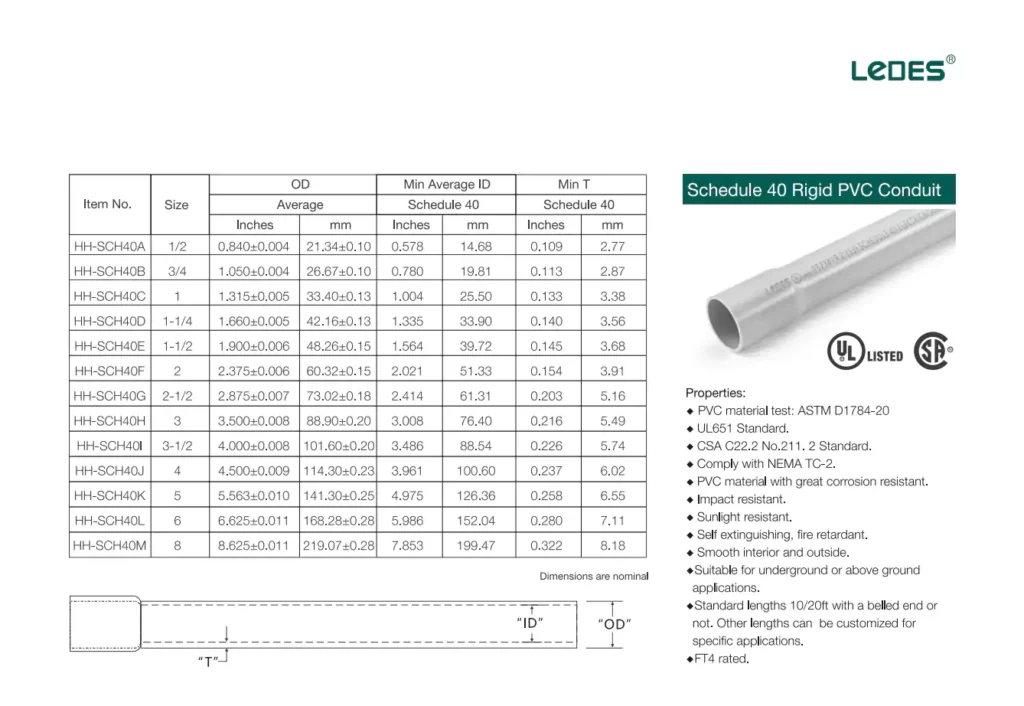
일정 40 도관 무역 규모(미국)
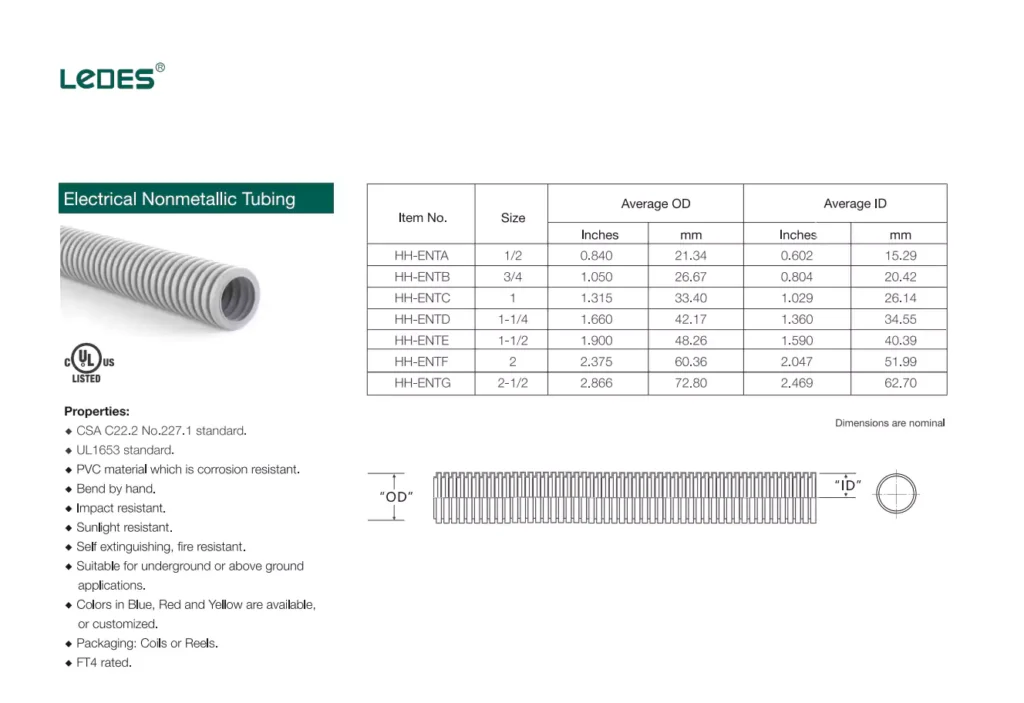
이비인후과 도관 무역 규모(캐나다)
크기가 작은 도관: 과도한 열 축적으로 인해 과열, 단열재 손상, 심지어 화재까지 발생할 수 있습니다. 이는 심각한 안전 위험을 초래하며, 값비싼 수리 또는 사고로 이어질 수 있습니다.
대형 도관: 겉보기에는 나아 보이지만, 불필요한 자재 비용, 무게 증가, 차량 설계에 대한 잠재적 간섭으로 이어질 수 있습니다.
뛰어난 성능으로 유명한 테슬라 로드스터는 상당한 전류 흐름을 필요로 하는 고출력 충전 시스템을 사용합니다. 테슬라 엔지니어들은 안전성이나 효율성을 저해하지 않으면서도 이처럼 까다로운 전류를 처리할 수 있도록 적절한 직경의 도관을 신중하게 선택했습니다. 너무 작은 도관은 충전 속도를 크게 저하시키고 화재 위험을 초래했을 것입니다.
자동차 전선 제품 협회(AWPA)의 수석 전기 엔지니어인 존 스미스는 "적절한 전선관 크기를 선택하는 것은 완벽한 퍼즐 조각을 찾는 것과 같습니다."라고 설명합니다. "최적의 성능과 안전을 보장하기 위해 전류 용량, 전선 규격, 환경 요인, 그리고 전반적인 차량 설계의 균형을 맞추는 것이 중요합니다."
자동차 컨설팅 리소스에는 다음이 있습니다.
국가 전기 규정(NEC):
차량의 안전한 전기 설비에 대한 지침을 제공합니다.
SAE 표준:
자동차 배선 및 도관 크기에 대한 구체적인 권장 사항을 제공합니다.
제조업체 사양:
정확한 전선관 요구 사항에 대해서는 항상 차량 제조업체의 지침을 참조하세요.
지역 코드:
전선관과 PVC 전선관은 매우 유사합니다. 자동차 전선관 자체뿐만 아니라 초고속 충전소의 케이블 전선관 설치 및 보호까지 고려해야 하기 때문입니다.
북미를 예로 들어 보겠습니다. 현재 미국의 UL 651 표준(경질 PVC 전선관에 적용)이나 UL 1653 또는 체코 공화국 C22.2 이비인후과용 도관에 대한 NO. 227.1:19 표준은 모두 준수해야 할 사양입니다. 동시에 내화성 또한 중점적으로 고려해야 할 요소입니다. 따라서 UL94 V-0 또는 FT4 관련 시험 및 인증을 받는 것이 매우 중요합니다.
전선관 크기에 영향을 미치는 요소를 이해하고 업계 표준을 활용하면 자동차 전기 시스템이 안전하고 효율적이며 안정적으로 작동하도록 할 수 있습니다.
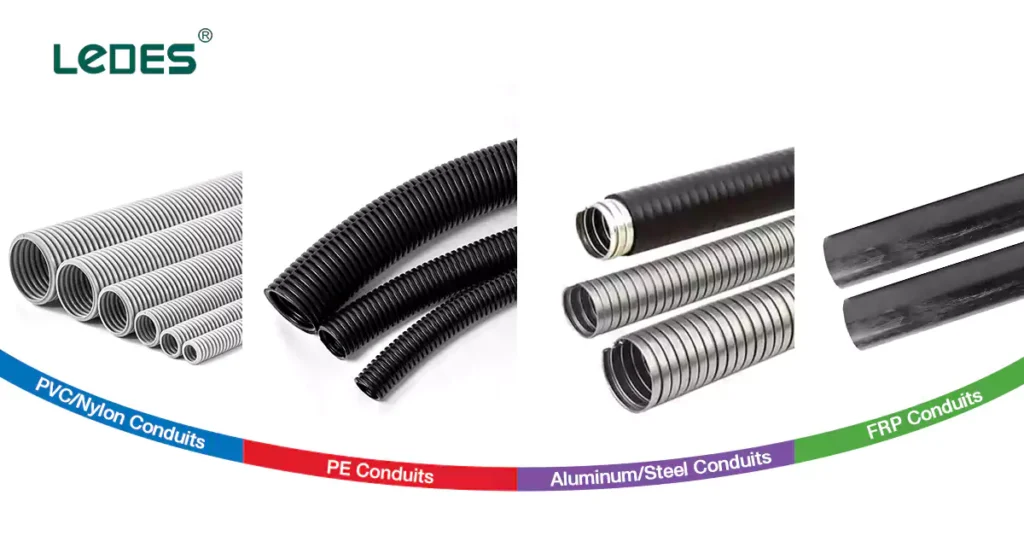
현대 자동차의 엔진룸 아래에는 복잡한 전기 시스템 네트워크가 쉴 새 없이 돌아가고, 필수적인 전류를 안전하고 효율적으로 전달하는 특수 도관으로 구동됩니다. 하지만 이 숨겨진 영웅들이 다양한 소재로 제작되고, 각 소재마다 고유한 강점과 한계를 가지고 있다는 사실, 알고 계셨나요?
이 다재다능한 전선관은 뛰어난 유연성, 내충격성, 그리고 비용 효율성을 제공합니다. 설치가 용이하고 내구성이 뛰어나 자동차 배선 하네스의 저전압 및 중전압 애플리케이션에 널리 사용됩니다.
사례 연구: 고전 자동차 복원에서 PVC 도관 원래의 미적 감각을 그대로 재현하면서도 전기 부품에 안정적인 절연을 제공하는 능력 때문에 선호되는 경우가 많습니다.
PE 도관은 높은 유연성, 내화학성, 그리고 우수한 유전 특성을 자랑합니다. 특히 습기 및 환경 요인에 대한 내구성이 요구되는 자동차 분야에 매우 적합합니다.
Grand View Research가 2021년에 발표한 보고서에 따르면, 글로벌 폴리에틸렌 시장은 2030년까지 1조 4천억 달러 규모에 이를 것으로 예상되며, 이는 자동차를 포함한 다양한 산업에서 널리 사용되고 있기 때문입니다.
금속 도관은 열가소성 도관보다 무겁지만, 우수한 전기 전도성과 전자파 간섭(EMI) 차폐 기능을 제공합니다. 고전압 애플리케이션이나 EV 배터리 시스템과 같이 EMI 보호가 중요한 분야에 자주 사용됩니다.
사례 연구:
테슬라의 모델 S 플레이드는 알루미늄 도관을 사용하여 고성능 전기 구동장치 내부에서 흐르는 상당한 전류를 관리하여 안전하고 효율적인 전력 공급을 보장합니다.
FRP 도관은 강도, 경량성, 뛰어난 내식성이 결합되어 있어 혹독한 환경에 노출되거나 긴 수명이 필요한 용도에 이상적입니다.
자동차 혁신 센터의 재료 엔지니어인 데이비드 리는 "극한의 기후나 오프로드 조건에서 작동하는 전기 자동차의 경우 FRP 도관은 까다로운 환경적 요인을 견딜 수 있는 견고한 솔루션을 제공합니다."라고 말했습니다.
자동차 전선관 재료의 미래는 다음과 같이 전개될 것으로 예상됩니다.
지속 가능하고 재활용 가능한 재료의 사용이 늘어납니다.
강도 대 중량 비율이 향상된 복합재 개발
실시간 모니터링 및 진단을 위한 스마트 센싱 기술의 통합.
특정 용도에 적합한 소재를 선택하는 것은 안전성, 성능 및 수명을 보장하는 데 매우 중요합니다. 각 소재의 특성과 용도를 이해하면 차량의 전기 인프라와 관련하여 정보에 기반한 결정을 내릴 수 있습니다.
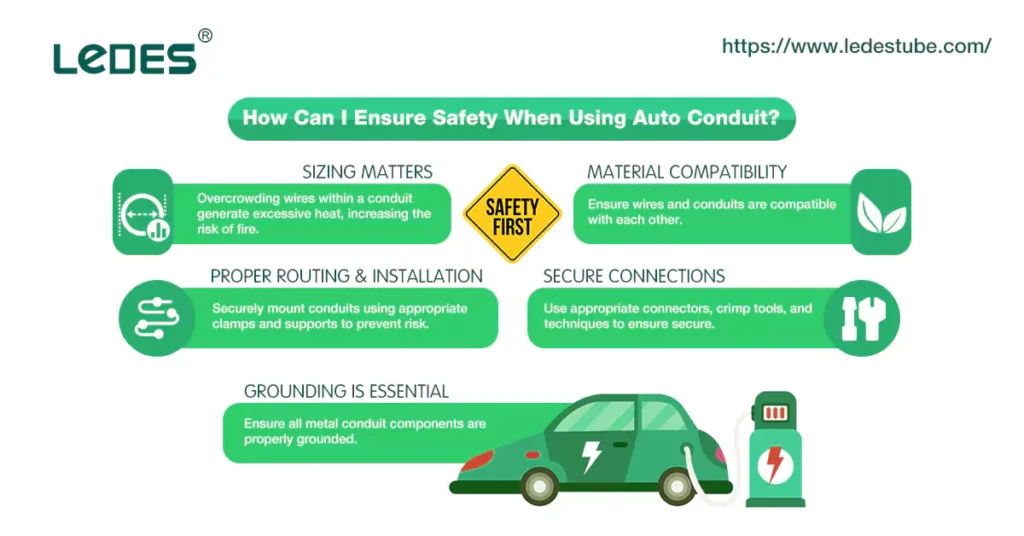
자동차 전선관은 차량 전기 시스템의 숨은 영웅으로, 안전하고 효율적인 전력 공급을 보장합니다. 하지만 다른 필수 부품과 마찬가지로 부적절한 취급이나 설치는 심각한 결과를 초래할 수 있습니다.
자동차 배선 작업 시 안전을 최우선으로 하는 것은 타협할 수 없는 부분입니다. 다음은 필수적인 작업 지침입니다.
전선관 내에 전선이 너무 많으면 과도한 열이 발생하여 절연 파괴 및 화재 위험이 커집니다. 또한, 전선관 크기가 너무 작으면 과열 및 손상으로 이어질 수 있습니다.
미국소방협회(NFPA)에 따르면, 미국에서는 매년 약 46,000건의 주택 화재가 전기적 결함으로 인해 발생하는 것으로 추산되며, 이는 적절한 규모의 화재 발생이 얼마나 중요한지를 보여줍니다.
전압 정격, 온도 저항성, 화학적 호환성 등의 요소를 고려하여 전선과 도관이 서로 호환되는지 확인하세요.
호환되지 않는 전선관 재질을 사용한 잘못된 설치로 인해 클래식카 배선 시스템의 절연 파괴가 발생하여 운행 중 화재가 발생했습니다. 호환성 지침은 항상 제조업체 사양을 참조하십시오.
적절한 커넥터, 압착 공구 및 기술을 사용하여 전선관 내 안전하고 진동에 강한 연결을 확보하십시오. 느슨한 연결은 아크, 단락 또는 심지어 회로 완전 고장으로 이어질 수 있습니다.
산업 표준: 그만큼 SAE(미국 자동차 엔지니어 협회) 차량의 전기 커넥터 설계 및 설치 관행에 대한 세부적인 표준을 제공합니다.
전선은 열원, 날카로운 모서리, 과도한 진동이 발생하는 곳으로부터 멀리 설치하십시오. 전선의 움직임과 손상을 방지하기 위해 적절한 클램프와 지지대를 사용하여 전선을 단단히 고정하십시오.
모든 금속 도관 구성 요소가 적절히 접지되어 고장 전류에 대한 안전한 경로를 제공하고 감전이나 부상의 위험을 최소화하도록 하세요.
자동차 안전 연구소(Automotive Safety Institute)의 수석 전기 엔지니어인 메리 존슨(Mary Johnson)은 "자동차 전선관 작업 시에는 항상 안전이 최우선입니다."라고 강조합니다. "업계 표준을 준수하고, 적절한 재료와 기술을 사용하며, 안전한 연결을 최우선으로 하는 것은 잠재적 위험을 예방하는 데 매우 중요한 단계입니다."
정기적으로 차량의 배관 시스템을 검사하여 마모, 손상 또는 느슨한 연결 흔적이 있는지 확인하세요.
복잡한 배선이나 도관 수리에 대해서는 자격을 갖춘 전기 기술자에게 문의하세요.
이러한 안전 수칙을 준수하면 자동차 배선의 안정적인 작동을 보장하고 차량과 본인을 전기 위험으로부터 보호할 수 있습니다. 안전은 단순히 우선순위가 아니라 안전하고 즐거운 운전 경험의 기반임을 기억하세요.
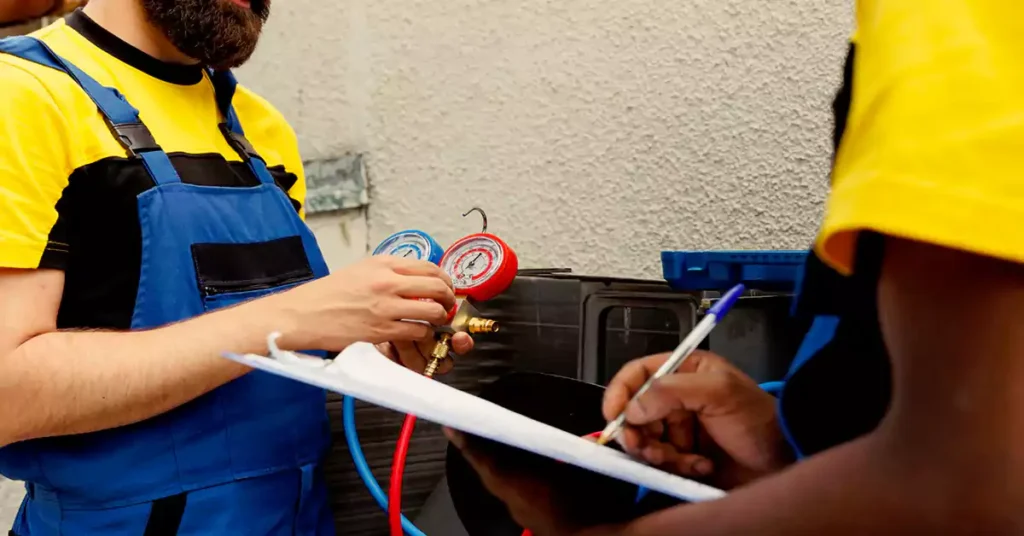
자동차 배선 시스템은 차량 전기 인프라의 숨은 영웅이라고 할 수 있습니다. 흔히 보닛 아래에 숨겨져 있지만, 모든 구성 요소에 안전하게 전원을 공급하는 데 중요한 역할을 합니다. 다른 중요 시스템과 마찬가지로 정기적인 유지 보수는 최적의 성능과 수명을 보장합니다.
Neglecting your conduit system can lead to overheating, short circuits, malfunctions, and even fires – consequences no driver wants to face. Here’s how to keep your auto conduits running smoothly:
Regularly inspect conduits for signs of wear, damage (cracks, cuts, abrasions), loose connections, or excessive heat buildup. Early detection is crucial for preventing serious issues down the road.
사례 연구: A 2019 report by the National Highway Traffic Safety Administration (NHTSA) highlighted that a frayed wiring harness, leading to exposed wires within a conduit, was a contributing factor in a vehicle fire incident.
Examine connectors for corrosion, looseness, or signs of overheating. Securely tighten any loose connections and replace damaged connectors as needed.
산업 표준: The SAE (Society of Automotive Engineers) provides specific guidelines for connector installation and maintenance practices to ensure secure and reliable connections.
Inspect conduits for areas where they rub against sharp edges, moving parts, or other components. Use protective sleeves, padding, or adjust routing to minimize chafing and prevent insulation damage.
A study by the Society of Automotive Engineers (SAE) found that improper conduit routing was a common cause of wiring failures in vehicles, leading to electrical malfunctions and potential safety hazards.
Excessive heat can degrade conduit materials and insulation. Check for signs of overheating near high-current components or in areas with poor ventilation.
전문가의 관점:
“Regularly checking for temperature fluctuations around conduits is essential,” states Dr. Emily Chen, Lead Materials Engineer at the Automotive Industry Association (AIA). “High temperatures can significantly impact material lifespan and lead to premature failures.”
For complex repairs, troubleshooting electrical issues, or if you’re unsure about any aspect of conduit maintenance, consult a qualified electrician specializing in automotive systems.
Proactive Maintenance Saves You Down the Road:
By incorporating these practices into your vehicle care routine, you can prevent costly repairs, ensure safe operation, and prolong the life of your auto conduit system. Remember: a little preventative care goes a long way in keeping your ride running smoothly and safely.
Your vehicle’s auto conduit system acts as the silent guardian of its electrical network, channeling power safely and efficiently. But like any complex system, it can sometimes encounter problems. Knowing how to troubleshoot these issues can save you headaches, repair costs, and even potential hazards.
Here’s your roadmap to diagnosing and addressing common auto conduit troubles:
The first step is recognizing the signs. Look for flickering lights, blown fuses, electrical component malfunctions, or unusual noises (buzzing, crackling) near the conduits.
A study by AAA found that faulty wiring and electrical system problems account for over 20% of vehicle repair claims annually, highlighting the prevalence of conduit-related issues.
Examine conduits thoroughly for cracks, cuts, loose connections, chafing, or signs of overheating.
사례 연구: A customer reported intermittent dashboard warning lights and a malfunctioning power window. Upon inspection, a technician discovered a rodent bite on an auto conduit near the engine compartment, disrupting electrical flow.
Inspect connectors for corrosion, loose wires, or damage to pins. Use a multimeter to test voltage continuity at each connection point.
산업 표준: The SAE (Society of Automotive Engineers) provides detailed guidelines for connector inspection and testing procedures in their automotive wiring standards.
Ensure all metal conduit components are securely grounded using a grounding strap or bolt. Use a multimeter to check ground continuity by placing one probe on the conduit and the other on a known ground point.
전문가의 관점:
“Proper grounding is crucial for safety,” explains John Smith, Lead Electrical Engineer at the Automotive Safety Institute. “A faulty ground connection can lead to electrical shocks or even damage to electronic components.”
Carefully inspect the wiring harness within the conduit for broken strands, frayed insulation, or pinched wires. Replace any damaged sections of the harness.
For complex issues or if you’re uncomfortable diagnosing and repairing electrical problems yourself, consult a qualified automotive electrician. They have the expertise and tools to pinpoint the issue accurately and ensure a safe repair.
By following these troubleshooting steps, you can become more confident in addressing common auto conduit issues. Remember, prompt action prevents minor problems from escalating into major headaches and potential safety hazards.
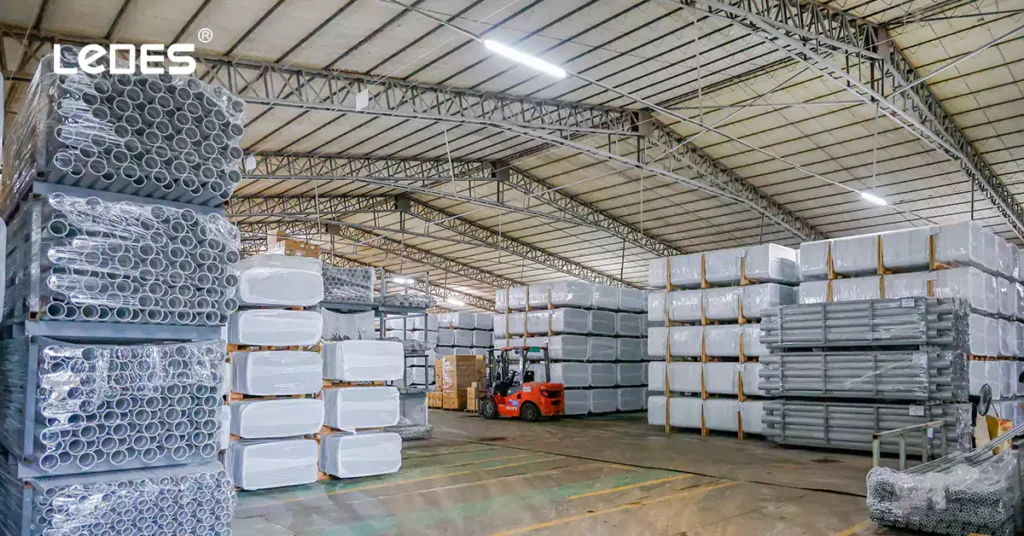
When it comes to your vehicle’s electrical system, reliability is paramount. Selecting the right auto electrical conduit supplier can make all the difference between a smooth-running engine and a potential nightmare scenario.
Here’s how to navigate the market and find a supplier worthy of your trust:
Look for suppliers with a proven track record in the automotive industry. Years of experience translate to deep understanding of material properties, application-specific requirements, and evolving industry standards.
사례 연구: A renowned motorsport team switched to a new conduit supplier for their racing vehicles. The switch resulted in improved conductivity and superior temperature resistance, contributing to a significant performance boost during competitive events.
Demand Assurance: Request certifications like ISO 9001 (Quality Management), AS9100 (Aerospace), or industry-specific automotive standards. These demonstrate commitment to quality control and material integrity.
A report by the American Automotive Association (AAA) highlighted that using non-compliant materials in vehicle repairs can lead to malfunctions, safety hazards, and costly repairs down the line.
Assess if the supplier offers a diverse range of conduit types (PVC, nylon, metal, etc.) and sizes to meet your specific needs.
전문가의 관점:
“A reputable supplier will understand that one size doesn’t fit all,” says Sarah Johnson, Lead Engineer at Auto Wire Solutions. “They should offer customization options for unique applications and vehicle models.”
Look for suppliers who provide prompt customer service, technical support, and readily available resources (e.g., application guides, installation manuals).
사례 연구: A small repair shop praised a particular auto wire conduit supplier for their exceptional technical assistance in troubleshooting a complex wiring issue, ultimately saving them valuable time and resources.
Compare quotes from multiple suppliers while considering overall value, not just the lowest price. Factor in lead times, delivery options, and potential bulk discounts.
Choosing a reliable auto conduit supplier is an investment in your vehicle’s performance and safety. By prioritizing experience, quality, support, and customization, you set yourself up for success and long-lasting reliability on the road ahead.
The automotive industry is on the cusp of a revolution, driven by electrification, autonomous driving, and advanced connectivity. This rapid evolution necessitates a transformation in every aspect of vehicle design, including the often-overlooked world of wiring conduits.
Here’s a peek into the exciting future of auto conduits:
As vehicles strive for greater fuel efficiency and range (especially in EVs), lightweight materials like carbon fiber composites, fiberglass reinforced plastics (FRP), and even advanced polymers will become increasingly prevalent.
사례 연구: Tesla’s Model S Plaid utilizes a combination of aluminum and composite materials in its wiring harnesses, significantly reducing weight without compromising strength or conductivity.
A 2023 report by Grand View Research projects the global automotive sensors market to reach $169 billion by 2030, highlighting the increasing integration of sensing technologies into vehicles.
Integration of Sensors: Future conduits could incorporate embedded sensors for real-time monitoring of temperature, pressure, vibration, and even electrical current flow. This data can help predict potential failures, optimize performance, and enable proactive maintenance.
Imagine an auto conduit that can repair minor damage autonomously! Research into self-healing materials is progressing rapidly, offering the potential for enhanced durability and extended service life.
전문가의 관점:
“The future of auto conduits lies in smart integration,” says Dr. Emily Chen, Lead Materials Engineer at the Automotive Industry Association (AIA). “Self-healing capabilities could revolutionize maintenance procedures and significantly improve safety.”
Wireless charging is already becoming commonplace in smartphones and other devices. This technology holds immense potential for vehicles, eliminating the need for physical connections between the battery and electrical components, reducing cable clutter, and improving overall efficiency.
사례 연구: Companies like Local Motors are already exploring 3D printing to create custom conduits tailored to specific vehicle models and application requirements. This opens doors for greater design flexibility and on-demand manufacturing.
The future of auto conduits promises a dynamic shift towards smarter, lighter, and more resilient systems, ultimately contributing to safer, more efficient, and technologically advanced vehicles.
Thanks to the rapid development of electric vehicles, auto conduit has gone from an unnoticed conduit series to the current rapid development.
It works in harsh environments for a long time, so its performance is very important. At present, AAA has also established relevant standards. In this article, we also mentioned how to choose the right automotive electrical conduit, and type, material, etc., and how to maintain it during use.
This is all for this post. If you still have questions, you can submit a form or send an email to our experts, who will discuss specific solutions with you.

